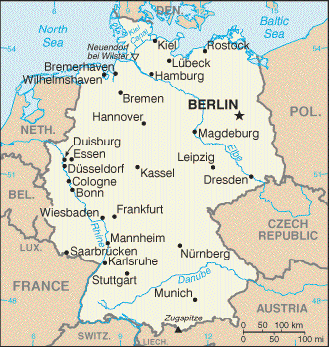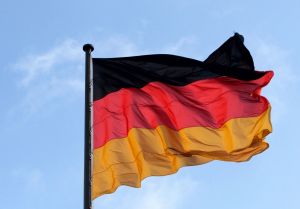Germany
Travel The World


Name: Germany or Federal Republic of Germany. Locally known as: Deutschland or Bundesrepublik Deutschland.
A country in central Europe. It is bounded on the north by the Baltic Sea, Denmark and the North Sea. On the east by
Poland and Czechoslovakia. On the south by Austria and Switzerland. On the west by France, Luxembourg, Belgium
and the Netherlands.
Border distances: Austria 784 km, Belgium 167 km, Czech Republic 646 km, Denmark 68 km, France 451 km,
Luxembourg 138 km, Netherlands 577 km, Poland 456 km, Switzerland 334 km.
Coastline: 2,389 km.
Land: Germany is divided into 5 main regions; the North German
Plain, the Central Upland, the Southwestern Mountains, the Alpine Foreland and the Bavarian Alps.
Ethnic groups: German, Turkish, others (made up largely of Greek, Italian, Polish, Russian, Serbo-Croatian, Spanish)
Religions: Protestant, Roman Catholic, Muslim,...
Languages: German
Berlin
Berlin is the capital city and a state of Germany. It is the country's largest city in area and population.Berlin is one of the
most influential centers in European politics and culture. The city serves as an important junction of national and conti-
nental transportation. Berlin is a major tourist and shopping destination and is well known for its diverse range of con-vention
venues and media outlets. The rapidly changing metropolis at present enjoys an international reputation for its festivals, vibrant
nightlife, contemporary architecture, and avant-garde arts.
Munich
Munich is the capital city of Bavaria, Germany. With a population of about 1.3 million, Munich is the third-largest city in
Germany. Munich is an important center of higher education, banking and the films and media industry.The city has
several important art museums, among them the Alte Pinakothek, Neue Pinakothek, and the Pinakothek der Moderne.
Famous tourist attractions include the the Frauenkirche (Cathedral of Our Lady), English Garden, the Deutsches
Museum (Science Museum), and the Rathaus-Glockenspiel.Perhaps Munich's most famous attraction is the
Oktoberfest, a 2-week-long fair.
Dresden is one of Germany's most beautiful cities and also capital of Saxony. This baroque metropolis experienced its
golden age in the first half of the 18th century under the rule of Augustus the Strong.
Attractions: numerous monuments and parks, Semper Opera House, the pompous complex of pavilions and galleries
called the Zwinger, the Royal Castle with the Green vault and the terraces of the Elbe riverside.
Potsdam is the capital of the state Brandenburg. It's a dream destination for everyone - a charming city surrounded by
idyllic lakes and forests.
Attractions: the Dutch quarter, the Russian Colony Alexandrovka and Belvedere Palace on the Pfingstberg, Cecilienhof -
Palace. Sanssouci Park, New Garden with Cecilienhof, Babelsberg and Glienicke with their castles, etc.
Hannover is one of the beautiful and charming cities in the north. The city was a former royal capital even having its
prince until these days.
Attractions: In the Inner city visit the Kroepcke, Hannover Zoo, Maschsee, Herrenhausergaerten - Royal Gardens - The
garden design is a copy of the Versailles.
Frankfurt is one of Germany's important cities, being the biggest international financial and trade center of Europe.It's
famous for it's skyline - a line of towering skyscrapers which is mostly consisting of banks and other financial
institutions.
The Old city:
The Roemer - Frankfurt's city hall
One of the most important historical old buildings, housing the election of the former German kings and emperors during
the early times. Since 1405, it has been used as the city hall. The area where the Roemer is, the Roemerberg, offers a
surrounding of beautiful old houses, used nowadays as stores and restaurants.
The Kaiserdom - Emperor's Cathedral
As the name says, the Emperor's Cathedral. This church was used as the venue of the coronation of the new emperor
or king. In front of this church is an archaeological finding of an ancient sauna used by the Romans when they were
colonizing the area.
Paulskirche - Paul's Church
This church was built during the end of the 18th century. From damages during the war, it was rebuilt in the mid 20th
century and considered one important attraction of the old city.
Goethe's House
Frankfurt is the home of Johann Wolfgang von Goethe, one of the world's most famous poets. The house of Goethe is
located in the inner city and is open for public viewing. The Goethe Museum is just right next to it, housing a very rich
Goethe collection.
A Walk Crossing the River Main
From the old city, you can walk down to the river then cross a pedestrian bridge called Eiserner Steg (iron bridge).
From the other side of the bridge, you can properly see the skyline. The road parallel to the river is called Museumufer -
Museums on the river bank - lining up a variety of museums. You can walk more until you arrive at another pedestrian
bridge called Holbeinsteg. After crossing that bridge, look for the Nizza Garden. This garden is unique because it
contains tropical plants and palms in an open German climate.
Cologne is the oldest city of Germany dating back to the times of the Romans and even got its name, Colonia, from
them since it was a colony of Rome in 50 A.D. The Romans also brought christianity to Cologne and had been a
residence to several bishops. Nowadays, you can still find some remains of Roman fortifications, churches and
buildings all over the city like the Roman North Gate, the City Hall, the Roman tower and the City Gates. Though
populated by several Roman churches like the Great St. Martin and St. Gereon churches, Cologne is more famous
for its landmark, the Cathedral of Cologne, world heritage site since 1998. The gothic Cathedral was built in 1248 and
finally completed in 1880. It houses the Relics of the Magi since the 13th century that made the city one of the famous pilgrim destinations.